
| Main Page |
| Photo Galleries |
| Writing |
| Aikido |
| Zen |
| Peeps |
| Links |
| Contact |
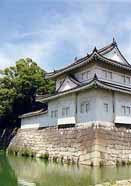
 Aikido
Aikido
For information and directions to the Budo Centre in Kyoto, click here.
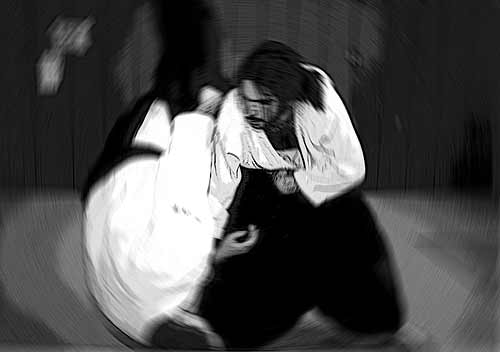 Aikido's
a funny thing; everyone seems to start it for different reasons, but once
started, it becomes difficult to stop. I met a guy in Tokyo who put it
perfectly: it just gets in your blood.
Aikido's
a funny thing; everyone seems to start it for different reasons, but once
started, it becomes difficult to stop. I met a guy in Tokyo who put it
perfectly: it just gets in your blood.
Though there are many who could explain Aikido far more eloquently and with considerably greater authority than myself, I would like to venture a few facts and maybe even an opinion or two about its practice.
Aikido is a form of martial arts developed in Japan that is based on the use of an opponent's energy to bring a confrontation to an end without violence or serious injury to either the defender or the attacker. This is done by using various joint manipulations, or by upsetting the balance of the attacker so that they become prone to the ever useful "force of gravity".
 Aikido,
however, does not only consist of throwing, but also in equal part is
made up of learning how to be thrown. At least that's how it starts. Early
on in one's Aikido practice, one must learn how to fall properly so as
not to be injured when thrown; a practice known by the Japanese word ukemi.
The faster or more direct the throw, the more difficult the ukemi
becomes, as can be seen in the picture to the left. Here, to avoid a particularily
direct and potentially injurious wrist lock, the uke (person
doing ukemi) is flipping his body through the air to, well, to
avoid having his wrist broken.
Aikido,
however, does not only consist of throwing, but also in equal part is
made up of learning how to be thrown. At least that's how it starts. Early
on in one's Aikido practice, one must learn how to fall properly so as
not to be injured when thrown; a practice known by the Japanese word ukemi.
The faster or more direct the throw, the more difficult the ukemi
becomes, as can be seen in the picture to the left. Here, to avoid a particularily
direct and potentially injurious wrist lock, the uke (person
doing ukemi) is flipping his body through the air to, well, to
avoid having his wrist broken.
As the student of Aikido progresses, so too does their practice of ukemi. Though the 'uke' in 'ukemi' means 'to receive' in Japanese, 'ukemi' can also mean 'to have lost the initiative'; which is an important part of understanding what the purpose of the practice actually is. As you progress in Aikido, you realize that the purpose of ukemi is to regain the initiative in a situation where you have clearly lost it (again, see above!).
The other side of Aikido is, of course, the techniques themselves. The
founder of Aikido - Morihei Ueshiba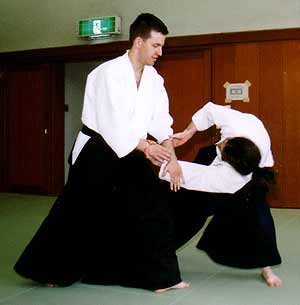 - was a master of several martial forms, but in developing Aikido he strove
to limit the destructive results of the techniques in such a way as to
allow the skilled practitioner to defend him or herself without disabling
or maiming their opponent. This has been on of my major attractions to
Aikido as a martial art. In the roughly 10 years that I have been training
in the martial arts, I have learned hundreds of techniques that - if I
actually ever used them on someone - would keep me from being able to
sleep at night or would most certainly put me in jail. Clearly, then,
those aren't techniques that I need to be practicing.
- was a master of several martial forms, but in developing Aikido he strove
to limit the destructive results of the techniques in such a way as to
allow the skilled practitioner to defend him or herself without disabling
or maiming their opponent. This has been on of my major attractions to
Aikido as a martial art. In the roughly 10 years that I have been training
in the martial arts, I have learned hundreds of techniques that - if I
actually ever used them on someone - would keep me from being able to
sleep at night or would most certainly put me in jail. Clearly, then,
those aren't techniques that I need to be practicing.
Aikido, then, has given me a way to practice the martial arts with a clear conscience. Though stabbing someone in the eye, or breaking their knees or bursting their eardrums may be effective in combat, I can honestly say that I wouldn't be comfortable doing such things to a person, especially if I had the ability to resolve the situation without causing such grievous harm.
And that begs a very serious question; why do a martial art at all?
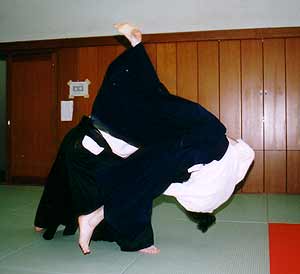 A
large part of my reasoning, to be perfectly honest, is that I want to
stay in shape. I lost about 30lbs. in one year practicing Aikido, which
isn't bad by any standard. I find weight training boring, but the seemingly
endless nuances of Aikido mean that it takes a lifetime to master...and
more's the better! That means it should keep me occupied for a while,
which is that much less time spent sitting on the couch!
A
large part of my reasoning, to be perfectly honest, is that I want to
stay in shape. I lost about 30lbs. in one year practicing Aikido, which
isn't bad by any standard. I find weight training boring, but the seemingly
endless nuances of Aikido mean that it takes a lifetime to master...and
more's the better! That means it should keep me occupied for a while,
which is that much less time spent sitting on the couch!
Beyond that, though, I believe that Aikido training is excellent for building discipline, learning about yourself and coming to a different understanding about interaction and conflict with other people.
I can also say that Aikido has taken me to some interesting places so far, and I'm continually impressed by the people who I meet in my practice. I've had the chance to practice at the world headquarters of Aikido in Tokyo under Moriteru Ueshiba, the grandson of the founder of Aikido; I've trained in the mountains of Kyoto in Kurama Temple; I went to Kurama Temple again, this time as a part of an Aikido demonstration honouring Minamoto Yoshitsune in the Yoshitsune-sai Festival.
I am now training in the Kyoto City
Budo Center, which was created by the Japanese government in 1983
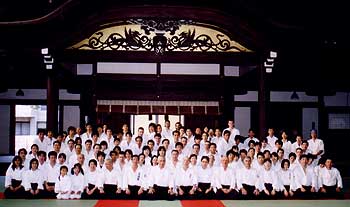 to
act as a comprehensive martial arts training centre in order to preserve
Japan's traditional fighting arts. The main training hall was built in
1899, and has been designated by the Government as a Cultural Asset, as
it is the oldest martial arts training hall in the country. Besides Aikido,
one can also go to the Budo Centre to study Kyudo (archery), Kempo (a
style of Karate), Judo, Kendo (fencing), Iaido (sword drawing) and Sumo.
to
act as a comprehensive martial arts training centre in order to preserve
Japan's traditional fighting arts. The main training hall was built in
1899, and has been designated by the Government as a Cultural Asset, as
it is the oldest martial arts training hall in the country. Besides Aikido,
one can also go to the Budo Centre to study Kyudo (archery), Kempo (a
style of Karate), Judo, Kendo (fencing), Iaido (sword drawing) and Sumo.
In March of 2004 I received my Shodan, or first degree black belt, in Aikido from Nomura Shihan at the Budo Center. The test was obviously the culmination of a lot of efforts in training so far, but more than that it was also an "x" on my list of things to do in life.
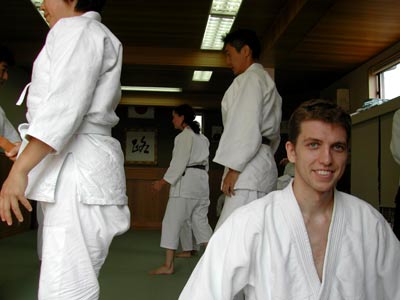 And
that links into one of tshe most significant lesson that I have learned
in Aikido, though it is actually quite a simple thing: your actions are
your life. Lots of people talk about doing things, but talk is cheap if
you don't actually act. It seems like a pretty basic thing to take out
of so much practice, but it's difficult to actually apply it. There's
little point in talking about things you'll never do, but life becomes
very interesting when you do the things that other people only talk about.
And
that links into one of tshe most significant lesson that I have learned
in Aikido, though it is actually quite a simple thing: your actions are
your life. Lots of people talk about doing things, but talk is cheap if
you don't actually act. It seems like a pretty basic thing to take out
of so much practice, but it's difficult to actually apply it. There's
little point in talking about things you'll never do, but life becomes
very interesting when you do the things that other people only talk about.